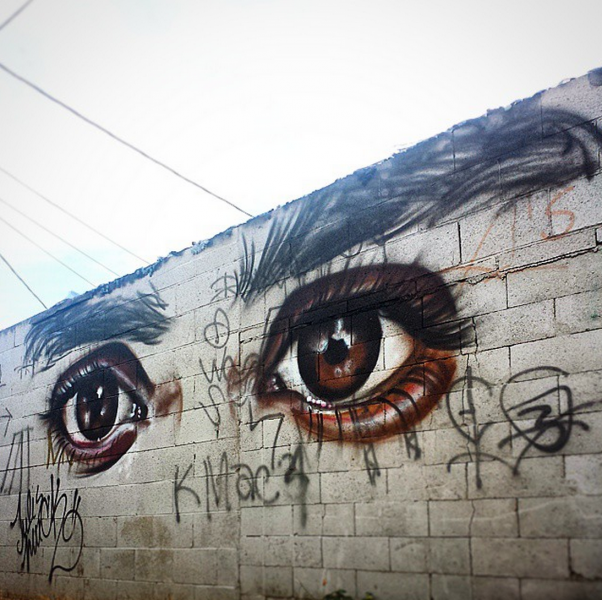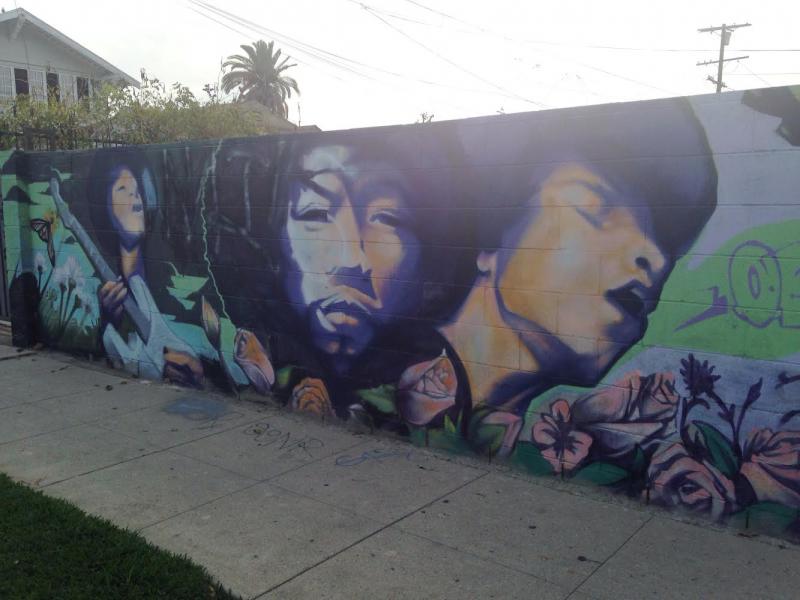South L.A. Artists Can't Afford The Mural Ordinance

In his off hours, Ayala finds business owners in South L.A. and matches them up with muralists willing to donate their time. He documents the resulting wall art on Instagram as @SmileSouthCentral.
“You have beautiful walls splattered with Corona,” Ayala says he told one liquor store owner. “Why don’t you let me put art up? [I’ll] bring in artists. Let them come over here and beautify the city.”
Just over a year ago, the Los Angeles City Council voted to legalize murals in L.A., overturning an 11-year ban that halted mural production in a city once known as a hotbed for public wall art.
READ MORE: Mural Ban Tentatively Lifted Throughout Los Angeles
Since then, organizations like #SmileSouthCentral have made major headway in improving the South L.A. community.
Seeing how aims of the new Mural Ordinance are “encouraging artistic expression,” “fostering a sense of pride” and “preventing vandalism,” the less-affluent area seems like a prime candidate for new murals. Both Bernard Parks of City Council District 8 and Curren Price of District 9 supported measures to preserve the Mural Ordinance and direct funding toward murals.
The Mural Ordinance asks muralists to register their works with the Department of Cultural Affairs. By doing so, the muralists win some protection for their art. Murals have a much better chance of surviving complaints from the public if they’ve already been approved by the city.

According to Yami Duarte, an Arts Associate in the DCA’s murals program, the DCA has received a total of 34 applications for murals on L.A. private property. Out of those 34 applications, two have been in District 9 and none in District 8. One of the two is currently in progress, and the other application expired due to a lack of funding.
READ MORE: L.A.'s Battle Over Murals
None of the muralists who have recently worked in South L.A. have chosen to register their murals. Why?
"I like to paint. I don’t like to file permits,” says Jules Muck, a muralist who recently worked on one of Ayala’s #SmileSouthCentral projects.
About those permits: let’s say you want to register a mural. From my count on the application, you must prepare a minimum of 14 documents including forms, permits, notices, photographs, measurements, artistic renderings and a “covenant” after the mural is complete, which must be signed, notarized, sent to the Department of Cultural Affairs for a signature, recorded with the Los Angeles County Clerk, and then re-sent to the Department of Cultural Affairs. All to paint something on, say, the side of your house.
“I can understand that’s daunting for artists,” says Duarte. “We don’t have so many individual artists doing [paperwork.]”

Beyond that, registering a mural is expensive. In addition to the $60 application fee and the considerable cost of time spent applying for the registration, all murals must be coated with an anti-graffiti product that makes them easy to clean if they get tagged.
The Home Depot offers anti-graffiti options running between $37.97 and $123.98 per gallon, and Ayala says he’d need four or five gallons to coat one of his projects.
Ayala said he’s hoping to find local business or galleries to help pay for the graffiti coating, but for now he can’t afford it. He’s operating without much capital: all his artists donate their time, and he pointed out that the building owners he works with don’t have much money to spare, either. No money, no registration.
Ironically, what’s drawn some muralists to paint in South L.A. this past year is not the new mural registration system, but the lack of prosecution against unregistered murals there.
“It’s pretty laid back,” Muck says of South L.A.’s attitude toward murals. “Really, we started painting in bad neighborhoods to avoid bureaucracy.”
She’s noticed that people don’t complain as much about murals there as they do in more affluent areas like Venice. Perhaps, she suggested, that’s because people there are more appreciative of efforts to beautify their area, or perhaps it’s because other, larger issues take priority.

“It’s a real transitioning neighborhood,” notes Lucy Mesa, who directs South L.A. efforts for Beautify Earth, a nonprofit organization with similar goals to #SmileSouthCentral. Mesa said that many artists are choosing to move into the South L.A. area from Santa Monica and Venice. “We are all co-creating a better place.”
READ MORE: Downtown Artists Paint To Change Skid Row
It seems the neighborhood largely welcomes the new art. “The people who live there really, really appreciate [a mural],” said Mesa. “It changes their ways of how they used to look at that spot.”
Ayala explained that his work fosters community pride and helps build a positive environment. He said that people love to gather around the muralists while they paint.
“The business owners are really cool about it,” he said. “They can’t give us any money, but they will support us. They’ll bring sandwiches.”
The visiting artists act as role models for local kids. “The artists are showing them how to paint with spray cans and easels,” he said. “A lot of kids ask the artists how to learn. [And then] they’re moving in a different direction [away from trouble.]”
A year after the Mural Ordinance’s passing, it seems that what the new system intends to do is truly happening in South L.A. – but it’s happening independently, outside the operations of the Ordinance. So how can the DCA adjust the registration system to accommodate the needs of these artists?
READ MORE: Garcetti: Foster the People Mural Can Stay in Downtown L.A.
Figuring out better funding is the first step, since the cost of filing a registration makes the system regressive. In May, Price and Parks of South L.A. were among City Council members who approved an allocation of $20,000 per district next year for new murals.
However, these murals will be commissioned through the Department of Cultural Affairs. That’s still no help for organizations working independently like #SmileSouthCentral and Beautify Earth.
Kimberly Briggs, Parks’ press and media deputy, said in an email that “at this time, [District 8 does] not have a partner/program that assists artists who do not receive funding from the city.”
Solutions to this and other problems aren’t coming quickly or cleanly. Duarte says the DCA is still working out the kinks.
“It’s only been a year. It’s a learning process. But the applications are getting much better and smoother, and the application process has developed over the year.”
“I’d like to get a thing with the [DCA] started,” said Ayala. Maybe by this time next year, he’ll be able to.
Contact Senior Arts Editor Gigi Gastevich here.



